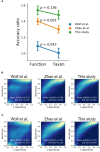Taxonomic and Functional Dysregulation in Salivary Microbiomes During Oral Carcinogenesis
- PMID: 34604102
- PMCID: PMC8482814
- DOI: 10.3389/fcimb.2021.663068
Taxonomic and Functional Dysregulation in Salivary Microbiomes During Oral Carcinogenesis
Abstract
Exploring microbial community compositions in humans with healthy versus diseased states is crucial to understand the microbe-host interplay associated with the disease progression. Although the relationship between oral cancer and microbiome was previously established, it remained controversial, and yet the ecological characteristics and their responses to oral carcinogenesis have not been well studied. Here, using the bacterial 16S rRNA gene amplicon sequencing along with the in silico function analysis by PICRUSt2 (Phylogenetic Investigation of Communities by Reconstruction of Unobserved States 2), we systematically characterized the compositions and the ecological drivers of saliva microbiome in the cohorts of orally healthy, non-recurrent oral verrucous hyperplasia (a pre-cancer lesion), and oral verrucous hyperplasia-associated oral cancer at taxonomic and function levels, and compared them with the re-analysis of publicly available datasets. Diversity analyses showed that microbiome dysbiosis in saliva was significantly linked to oral health status. As oral health deteriorated, the number of core species declined, and metabolic pathways predicted by PICRUSt2 were dysregulated. Partitioned beta-diversity revealed an extremely high species turnover but low function turnover. Functional beta-diversity in saliva microbiome shifted from turnover to nestedness during oral carcinogenesis, which was not observed at taxonomic levels. Correspondingly, the quantitative analysis of stochasticity ratios showed that drivers of microbial composition and functional gene content of saliva microbiomes were primarily governed by the stochastic processes, yet the driver of functional gene content shifted toward deterministic processes as oral cancer developed. Re-analysis of publicly accessible datasets supported not only the distinctive family taxa of Veillonellaceae and Actinomycetaceae present in normal cohorts but also that Flavobacteriaceae and Peptostreptococcaceae as well as the dysregulated metabolic pathways of nucleotides, amino acids, fatty acids, and cell structure were related to oral cancer. Using predicted functional profiles to elucidate the correlations to the oral health status shows superior performance than using taxonomic data among different studies. These findings advance our understanding of the oral ecosystem in relation to oral carcinogenesis and provide a new direction to the development of microbiome-based tools to study the interplay of the oral microbiome, metabolites, and host health.
Keywords: machine learning; microbiome dysbiosis; oral cancer; oral verrucous hyperplasia; saliva.
Copyright © 2021 Chen, Wu, Chiang, Chen, Wu and Wu.
Conflict of interest statement
The authors declare that the research was conducted in the absence of any commercial or financial relationships that could be construed as a potential conflict of interest.
Figures







Similar articles
-
Carcinogenesis of Male Oral Submucous Fibrosis Alters Salivary Microbiomes.J Dent Res. 2021 Apr;100(4):397-405. doi: 10.1177/0022034520968750. Epub 2020 Oct 22. J Dent Res. 2021. PMID: 33089709
-
Ecological shifts of salivary microbiota associated with metabolic-associated fatty liver disease.Front Cell Infect Microbiol. 2023 Feb 14;13:1131255. doi: 10.3389/fcimb.2023.1131255. eCollection 2023. Front Cell Infect Microbiol. 2023. PMID: 36864882 Free PMC article.
-
Dysbiosis of saliva microbiome in patients with oral lichen planus.BMC Microbiol. 2020 Apr 3;20(1):75. doi: 10.1186/s12866-020-01733-7. BMC Microbiol. 2020. PMID: 32245419 Free PMC article.
-
Microbial signatures of health, gingivitis, and periodontitis.Periodontol 2000. 2021 Jun;86(1):57-78. doi: 10.1111/prd.12362. Epub 2021 Mar 10. Periodontol 2000. 2021. PMID: 33690899 Review.
-
Oncobiome at the Forefront of a Novel Molecular Mechanism to Understand the Microbiome and Cancer.Adv Exp Med Biol. 2019;1168:147-156. doi: 10.1007/978-3-030-24100-1_10. Adv Exp Med Biol. 2019. PMID: 31713170 Review.
Cited by
-
The Intersection of the Oral Microbiome and Salivary Metabolites in Head and Neck Cancer: From Diagnosis to Treatment.Cancers (Basel). 2024 Oct 21;16(20):3545. doi: 10.3390/cancers16203545. Cancers (Basel). 2024. PMID: 39456639 Free PMC article. Review.
-
Systematic analyses uncover robust salivary microbial signatures and host-microbiome perturbations in oral squamous cell carcinoma.mSystems. 2025 Feb 18;10(2):e0124724. doi: 10.1128/msystems.01247-24. Epub 2025 Jan 28. mSystems. 2025. PMID: 39873508 Free PMC article.
-
The Composition and Functional Capacities of Saliva Microbiota Differ Between Children With Low and High Sweet Treat Consumption.Front Nutr. 2022 Apr 25;9:864687. doi: 10.3389/fnut.2022.864687. eCollection 2022. Front Nutr. 2022. PMID: 35558746 Free PMC article.
-
Salivary Microbiota Composition in Patients with Oral Squamous Cell Carcinoma: A Systematic Review.Cancers (Basel). 2022 Nov 4;14(21):5441. doi: 10.3390/cancers14215441. Cancers (Basel). 2022. PMID: 36358859 Free PMC article. Review.
-
No Clear Clustering Dysbiosis from Salivary Microbiota Analysis by Long Sequencing Reads in Patients Affected by Oral Squamous Cell Carcinoma: A Single Center Study.Cancers (Basel). 2023 Aug 22;15(17):4211. doi: 10.3390/cancers15174211. Cancers (Basel). 2023. PMID: 37686487 Free PMC article.
References
-
- Al-Hebshi N. N., Borgnakke W. S., Johnson N. W. (2019). The Microbiome of Oral Squamous Cell Carcinomas: A Functional Perspective. Curr. Oral. Health Rep. 6, 145–160. doi: 10.1007/s40496-019-0215-5 - DOI
Publication types
MeSH terms
Substances
LinkOut - more resources
Full Text Sources
Research Materials

